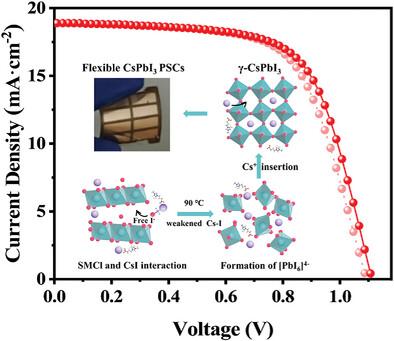当前位置:
X-MOL 学术
›
Adv. Energy Mater.
›
论文详情
Our official English website, www.x-mol.net, welcomes your
feedback! (Note: you will need to create a separate account there.)
Low‐Temperature Processed CsPbI3 for Flexible Perovskite Solar Cells Through Cs─I bond Weakening
Advanced Energy Materials ( IF 24.4 ) Pub Date : 2024-11-13 , DOI: 10.1002/aenm.202404293 Xuemin Guo, Wenxiao Zhang, Haobo Yuan, Zhengbo Cui, Wen Li, Ting Shu, Yunfei Li, Bo Feng, Yuyang Hu, Xiaodong Li, Junfeng Fang
Advanced Energy Materials ( IF 24.4 ) Pub Date : 2024-11-13 , DOI: 10.1002/aenm.202404293 Xuemin Guo, Wenxiao Zhang, Haobo Yuan, Zhengbo Cui, Wen Li, Ting Shu, Yunfei Li, Bo Feng, Yuyang Hu, Xiaodong Li, Junfeng Fang

|
All‐inorganic triiodide cesium lead (CsPbI3 ) exhibits huge potential in perovskite solar cells (PSCs). However, the high‐temperature crystallization process (≈340 or 180 °C) limits their further development, especially in flexible PSCs. Here, a Cs─I bond weakening approach is proposed to realize the low‐temperature crystallization of CsPbI3 by introducing organic sulfonate of 1‐propylsulfonate‐3‐methylimidazolium chloride (SMCl). SMCl can strongly interact with CsI and weaken the Cs─I bond to dissociate free I− ions for the effective transition of initial PbI2 to [PbI6 ]4− , which greatly decreases the crystallization temperature of black CsPbI3 to 90 °C. As a result, flexible PSCs are realized with efficiency of 13.86%, which is the highest efficiency of flexible CsPbI3 devices. Besides, SMCl will also help to release the tensile strain and stabilize CsPbI3 phase, leading to good thermal and mechanical stability. Almost no efficiency loss is observed in flexible PSCs after 36000 bending cycles with a curvature radius of 5 mm.
中文翻译:

低温加工的 CsPbI3 用于通过 Cs─I 键弱化的柔性钙钛矿太阳能电池
全无机三碘化物铯铅 (CsPbI3) 在钙钛矿太阳能电池 (PSC) 中表现出巨大的潜力。然而,高温结晶过程(≈340 或 180 °C)限制了它们的进一步发展,尤其是在柔性 PSC 中。在这里,提出了一种 Cs−I 键弱化方法,通过引入 1-丙基磺酸盐-3-甲基咪唑氯化物 (SMCl) 的有机磺酸盐来实现 CsPbI3 的低温结晶。SMCl 可以与 CsI 强烈相互作用并削弱 Cs−I 键以解离游离的 I− 离子,从而使初始 PbI2 有效转变为 [PbI6]4−,从而大大降低黑色 CsPbI3 的结晶温度至 90 °C。 结果,柔性 PSC 的效率为 13.86%,这是柔性 CsPbI3 器件的最高效率。此外,SMCl 还有助于释放拉伸应变并稳定 CsPbI3 相,从而获得良好的热稳定性和机械稳定性。在曲率半径为 5 mm 的 36000 次弯曲循环后,柔性 PSC 几乎没有观察到效率损失。
更新日期:2024-11-13
中文翻译:

低温加工的 CsPbI3 用于通过 Cs─I 键弱化的柔性钙钛矿太阳能电池
全无机三碘化物铯铅 (CsPbI3) 在钙钛矿太阳能电池 (PSC) 中表现出巨大的潜力。然而,高温结晶过程(≈340 或 180 °C)限制了它们的进一步发展,尤其是在柔性 PSC 中。在这里,提出了一种 Cs−I 键弱化方法,通过引入 1-丙基磺酸盐-3-甲基咪唑氯化物 (SMCl) 的有机磺酸盐来实现 CsPbI3 的低温结晶。SMCl 可以与 CsI 强烈相互作用并削弱 Cs−I 键以解离游离的 I− 离子,从而使初始 PbI2 有效转变为 [PbI6]4−,从而大大降低黑色 CsPbI3 的结晶温度至 90 °C。 结果,柔性 PSC 的效率为 13.86%,这是柔性 CsPbI3 器件的最高效率。此外,SMCl 还有助于释放拉伸应变并稳定 CsPbI3 相,从而获得良好的热稳定性和机械稳定性。在曲率半径为 5 mm 的 36000 次弯曲循环后,柔性 PSC 几乎没有观察到效率损失。


















































 京公网安备 11010802027423号
京公网安备 11010802027423号